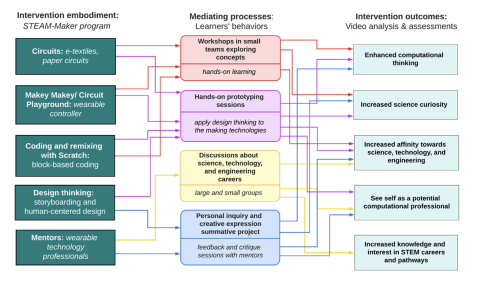Body
Image

Investigating the relationships among making, wearables, curiosity, computational thinking and STEM careers
This project focuses on youth-centered, culturally-relevant, out-of-school educational research and development. The team includes learning scientists and researchers, educators, directors and program administrators from Upward Bound and a makerspace/informal science institution, and engineering and wearable technology industry professionals. The STEM emphasis centers at the intersection of engineering and computational sciences, with content around coding digital technology and microcontrollers, and designing, developing and fabricating wearables and integrated systems. The project uses an iterative, design-based research methodology to lay the groundwork for design principles and empirical research findings on the relationships among curiosity, computational thinking, and STEM careers. It further provides feedback on how to foster equitable, out-of-school STEM secondary education, and informs broader STEM enrichment efforts at multiple Upward Bound sites nationally. The project has four objectives: (a) Testing and refining the STEM and arts-based curriculum, which includes hands-on, project-based activities; (b) Building design principles around the linkages between curiosity, computational thinking, and STEM careers; (c) Solidifying a research-practice partnership with learning scientists, educators, makerspaces, summer programs, and youth-serving organizations; and (d) Broadening underserved students’ participation through summer camps and school-year activities.
Pillar 1: Innovative Use of Technologies in Learning and Teaching
Our initial intervention includes: a) a curriculum that supports culturally-relevant and inclusive participation in e-textile making activities, and b) follow-up for participating high school students with interactions with engineering and scientists from wearable technology industries and academia. This two-year project will lay the groundwork for a revised summer camp curriculum, design principles, and empirical research findings on the relationships among curiosity, computational thinking, and STEM careers.
Pillar 2: Partnerships for Career and Workforce Preparation.
We will employ the multimodal framework to understand youths’ computational thinking concepts, practices, perspectives, and self-perceptions, and triangulate these results to youths’ measures on the science curiosity scale and STEM Career Interest Survey score. Recent CS and engineering graduates will serve as mentors. Near- peer mentoring) has been successfully applied in many informal STEM learning environments (Ross et al., 2018; Salzman & Strobel, 2011; Tenenbaum et al., 2014).
Pillar 3: Strategies for Equity in STEM Education
Our broader impacts and strategies for STEM educational equity include: (a) Addressing historic underrepresentation of low income and minoritized racial/ethnic youth in STEM through research-practice partnerships across Upward Bound sites; (b) Supporting iterative research on how science curiosity, STEM career interest, and computational thinking manifest in and can be enhanced through culturally-situated approaches; and (c) Augmenting research and practice through the development of design principles.

Discipline(s)
Computer and informational technology science
Data Science
Engineering
Target Gradespan(s)
Middle school (6-8)
High school (9-12)
Target Participant(s)
Youth / students
Educators
Girls (or women)
American Indian/Alaska Native participants
Black/African American participants
Hispanic/Latino participants
Students eligible for free lunch or reduced-price lunch
Other
Project Setting(s)
Informal Education
Category
Exploring Theory and Design Principles (ETD)